- Bernard Preston homepage
- Beekeeping
- Honey Glycemic Index
Honey Glycemic Index
Honey glycemic index tells just how quickly or actually moderately slowly, raw pollen-rich sugars are turned into blood glucose.
I have a confession to make. For one supremely interested in all things to do with bees and who considers himself a well-informed and interested person in the subject of GI, I have discovered that I was extremely ignorant of this aspect of the golden nectar of the bee. It turns surprisingly slowly into sugar in the blood stream.
Eaten together with some protein and fat, even diabetics can enjoy a delicious, sweet sandwich if it is made with the right flour. More about that lower down.
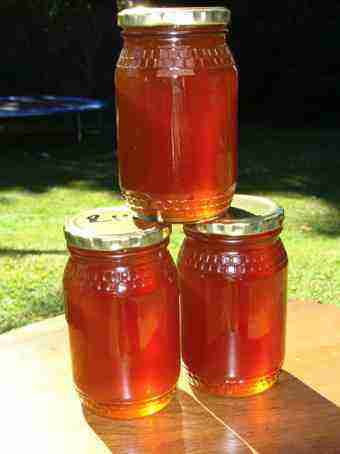
This page was last updated by Bernard Preston on 04th November, 2023.
Okay so I think I am a good DC, an experienced beekeeper and a bit of a know it all when it comes to natural living but I am also a lousy photographer; or rather a lazy one. That is my grandchildren's trampoline in the background. Just focus for the moment on the pure-gold in the foreground.
What is glycemic index and
why is it important? The GI of a carbohydrate gives us a numerical
measure on a scale of 1 to 100 revealing how quickly it is turned into glucose
in the blood stream. The figures are a bit arbitrary but generally these are the norm.
- above 70 is considered high GI.
- 55 to 70 is moderate GI
- below 55 is a low glycemic index food.
High glycemic foods are turned rapidly into glucose and cause a sudden rise in insulin to counter that raised blood-sugar.
One great difficulty is that the figures for Glycemic Index were produced after testing on healthy people. A person who is insulin resistant cannot assume that a low GI food will not spike their blood glucose. All obese people would greatly benefit from using a CGM for a month.
Only then would they know exactly how their bodies would respond to a particular carb.
If you are running a marathon, that glucose will be immediately used for energy. If you are sitting watching television, it will be turned to adipose tissue; fat, in short.
Insulin is the fat-hormone.
Repeated episodes of high blood sugar are very bad for the body, damaging in particular the capillaries and the nervous system so the pancreas is called upon to dump insulin into the plasma.
Honey Glycemic Index
Honey glycemic index questions whether all sweet foods are delicious but bad for you. Should they necessarily be avoided at all costs?
It would seem obvious that simple carbohydrates like table sugar and honey have high glycemic indices and complex starches like potatoes, rice and bread would be low values.
That is quite wrong, fortunately. Raw honey has a glycemic index of 55 which is borderline low, and baked potatoes, white rice and bread are all high. Even table sugar is well below that of these starches.
It's lucky so you can enjoy raw honey but it is unfortunate because if you have a weight or diabetic problem, you should avoid all refined starches and even potatoes, baked or boiled.
New potatoes luckily have far more "resistant starch."
Osteoporosis is one of those sequelae, hence my interest as a DC; but even worse blindness and all the vascular diseases associated with diabetes.
Much has to do with how refined a carbohydrate is. For example, white rice has a glycemic index of 89 which is extremely high, but unpolished it is 50. Cornflakes have a very high GI of 93 whilst even maize on the cob is only 60; in the moderate glycemic range.
Secondly, how a food is cooked is important. Baking and roasting raises the glycemic index, but boiling lowers it.
Baked potato comes in at a record-breaking 111; whilst boiled at 80 is also on the high side.
What about the honey glycemic index? Knowing that it is a saturated solution of fructose, glucose and sucrose, one would think that it would have a very high GI; at least that is what I have always assumed. But, no, it is only 55; it does not cause a blood sugar rush and is thus also not rapidly stored as fat.
You may well be confused by the published tables of indices; they vary quite considerably. The reason is simply that different kinds of potatoes and rice, for example can have very different glycemic indices.
What is more, a newly harvested potato is quite different to that which came out of cold storage.
Likewise honey from acacia trees has a low glycemic index, whilst that from citrus for example would have a higher value. Why is that? It all has to do with how much fructose there is in the nectar in the flowers.
Honey is a supersaturated solution of mainly fructose and glucose. The higher the percentage of the former, the lower the glycemic index; they are inversely related.
The fructose in honey varies between 30 and 44 percent.
High fructose honey also tends to stay runny; in theory it should have a lower GI.
However, there is a catch; do not assume that because a honey is runny, that is must have a lower glycemic index, and is therefore more healthy.
Over-processing of honey, as is the norm in the food industry will also keep it runny, because that is what the public wants; but it has a very high GI. I confess to being neurotically wary of all prepared items in the grocery store; they have often been ruined.
Newsletter
Our newsletter is entitled "create a cyan zone" at your home, preserving both yourself and Mother Earth for future generations; and the family too, of course. We promise not to spam you with daily emails promoting various products. You may get an occasional nudge to buy one of my books.
Here are the back issues.
- Lifestyle and ideal body weight
- What are ultra-processed foods?
- Investing in long-term health
- Diseases from plastic exposure
- Intensive lifestyle management for obesity has limited value
- A world largely devoid of Parkinson's Disease
- The impact of friendly bacteria in the tum on the prevention of cancer
- There's a hole in the bucket
- Everyone is talking about weight loss drugs
- Pull the sweet tooth
- If you suffer from heartburn plant a susu
- Refined maize meal and stunting
- Should agriculture and industry get priority for water and electricity?
- Nature is calling
- Mill your own flour
- Bake your own sourdough bread
- Microplastics from our water
- Alternative types of water storage
- Wear your clothes out
- Comfort foods
- Create a bee-friendly environment
- Go to bed slightly hungry
- Keep bees
- Blue zone folk are religious
- Reduce plastic waste
- Family is important
- What can go in compost?
- Grow broad beans for longevity
- Harvest and store sunshine
- Blue zone exercise
- Harvest and store your rainwater
- Create a cyan zone at your home
That fructose content not only affects the glycemic index but also how quickly the honey will set and herein lies a contradiction.
Nectar with fine, uniform crystals is a sign of a better product, despite its lower fructose content; and thus higher honey glycemic index. Unfortunately, when it comes to food, there is nothing simple.
One last point may be useful; to decrease the GI of any particular carbohydrate you must add fat and protein to it. So natural unprocessed honey and cheese on buttered wholewheat bread would belong to the low to moderate glycemic index foods.
If you are serious about wanting to enjoy the many benefits of honey as a sweetener over chemicals and highly refined sugar, then find a lightly-filtered source; preferably from a local beekeeper because of the regional pollen content.
Lightly-filtered honey is visually less attractive; it has the cloudy look of that shown above because of the pollen content. It will also set much faster; but it has two advantages.
Firstly the local pollen content gives you protection against the allergens in the air causing sinusitis and asthma.
And secondly pollen is the fat and protein source the bees must have. Allowing those nutrients to remain in the honey further lowers the glycemic index.
Provided it is not been heated which is rare in honey from your supermarket, if it is liquid then it has a lower GI; they are usually lighter in colour.
However beware, there is nothing simple in nutrition. Darker honeys, unless they have been heated provide more antioxidant protection due to the phenols present.
The long and the short of it is that it is a fine, healthy source of sweetening, especially if it's lightly filtered raw honey. A good sign of that is that it has lovely, uniform crystals.
Why does it crystallise and should you buy set or runny honey?
When you're in your parlour, Queen, rather have bread, cheese and honey; and do not forget the butter assuming you are enjoying plenty of high-fibre foods.
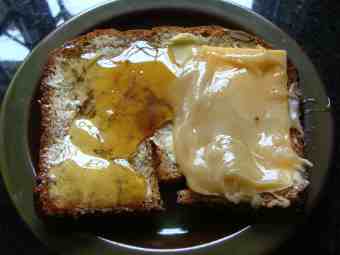
Glycemic index honey
See the fine, uniform crystals in last year's honey. On the left is the lightly-filtered honey from those bottles at the top of this page. Within a few weeks it will set and look exactly like the one on the right.
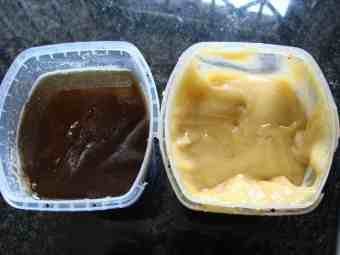
GI honey
To be quite certain, it is safer to buy honey like that on the right. You would not know whether that on the left is fresh like this one, straight from the hive, unless you know the beekeeper or whether it has been processed, heated and filtered.
The rule of thumb: buy that which is crystallised. Enjoy your raw honey with gusto and pleasure but of course it should be included in your calorie count if you are overweight. Adding a leaf of lettuce and making a sandwich would further improve matters. Try it, you won't be disappointed.
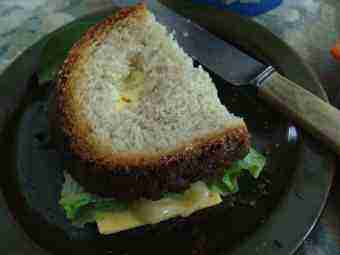
Honey, cheese and wholewheat bread = a low glycemic index sandwich. That's even more true if you use butter and add a leaf of lettuce.
Polyphenols in honey
"Polyphenols interfere with intestinal sugar transporters, modulating their function and altering glucose and fructose absorption."
- Food Reviews International, volume 35(4)
Natural honey is a remarkably complex food containing at least 181 different substances, according to researcher JW White; many of these are the polyphenols that help in giving protection against a wide range of diseases from tumours to heart conditions, stroke and even cataracts.
It is the presence of these polyphenols in natural honey that is thought to inhibit the absorption of glucose and fructose; thus they reduce raised blood glucose after meals.
They include quercetin and kaempferol and a host of other compounds.
Very low glycemic index
This is a fourth category sometimes used over and above high, moderate and low.
- High - 70 and up
- Moderate - 56 to 69
- Low - 55 or less
- Very low - 20 or less
Usually it applies to foods which combine these properties:
- Minimally ground
- Lightly cooked as possible
- Added protein
- Added fat.
Our authentic hummus recipe for example combines the low GI properties of chickpeas, added sesame seeds and olive oil for protein and fat; and parsley for more fibre.
Hummus has a GI of only 6. Add it to your salad for lunch; then you can enjoy your bread and honey utterly without guilt. The overall glycemic index of the meal would be very low.
So you see, honey glycemic index need hold no fears for you.
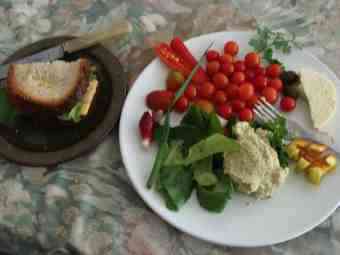
This is a very low glycemic index lunch; absolutely scrumptious and filling. I added an extra slice of homemade bread and mulberry jam.
Low GI bread
That notch seen in the slice of bread and honey above is significant; it is the sign of a homemade loaf baked in a machine.
By adding a protein like hummus and olive oil you can combine these properties to make your own low GI bread. It takes me five minutes only using our little oven. It is so easy, I don't understand why folk do not do it more often. Half the price of the supermarket low GI loaf and none of the chemicals added to the dough today. Like good raw honey, the glycemic index is not high.
I make no apology for recommending butter over margarine; if you're eating foods like these, fears of raised cholesterol will have no place among the terrors of the night.
Margarine is 50% trans isomers, proved to be very unhealthy and totally unnatural; nowhere are they found in nature. They are hydrogenated foods.
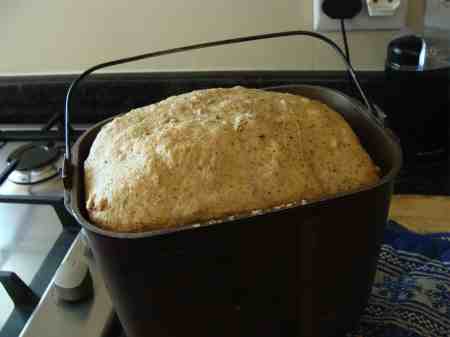
Glycoproteins
Glycoproteins are found on the outside of cell membranes; they can move about and interact with the inner environment. They consist of a glucose molecule attached to a protein. The spike that it forms is the site at which an invading virus gains entry into the tissues of our bodies[1].
Those with raised blood sugar are particular vulnerable to invading viruses. More than half of those dying in the pandemic are diabetic; this sets up the acute inflammatory response in the lungs that so frequently leads to death.
Many more no doubt are prediabetic, as I am; hence my interest.
Particularly at this time it behooves all of us to strictly limit those foods rich in sugars and refined carbohydrates that cause our blood glucose to soar. Whilst raw honey is not highly glycemic, I still recommend limiting it to a few teaspoons a day.
Commercial honey has a very high glycemic index[2].
Keep your blood glucose down by strictly limiting all refined starches and sugar; and taking a short walk after an indulgent meal.
Bernard Preston books
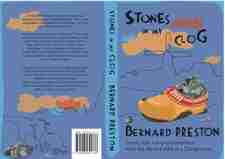
Have you bought one of my books yet? Have you enjoyed this page about honey? Then you will love the story about the argument that Bernie has with a Dutch radiologist who is also passionate about beekeeping; we did not discuss glycemic index though, a mistake perhaps in retrospect.
Read it on your Kindle or smartphone; no more long boring hours waiting in queues. This ebook is dirt cheap; the greed factor has set in for many ebooks but I keep it down for you. Kindle fiddles the price but it's about $4. You cannot go wrong.
When browsing use right click and "Open Link in New Tab" or you may get a bad gateway signal.
Did you find this page interesting? How about forwarding it to a friendly book or food junkie? Better still, a social media tick would help.
- Bernard Preston homepage
- Beekeeping
- Honey Glycemic Index
Address:
56 Groenekloof Rd,
Hilton, KZN
South Africa
Website:
https://www.bernard-preston.com